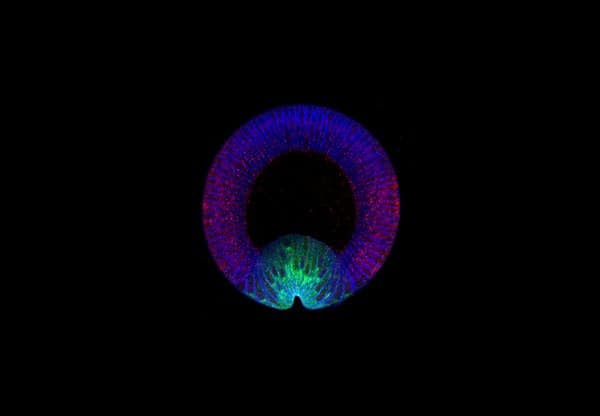Before the days of rote texting and email, if you wanted to communicate with a friend you might have personalized and assembled a physical letter. Similarly, the individual cells in our bodies communicate with each other by sending tailored “letters”—not with paper and pen, but in the form of proteins called ligands.
Researchers in the laboratory of Professor of Biology Angelike Stathopoulos study how to decode the language of ligands to understand cellular communication. Now, they have discovered new insights into how cells use one particular ligand to coordinate embryonic development.
A paper describing the study appears in the journal Current Biology on July 1.
The team uses the seemingly simple fruit fly, Drosophila melanogaster, as a model system for studying the basics of cellular signaling. While vertebrates like humans utilize 22 different ligands of the FGF (Fibroblast Growth Factor) family of proteins to send signals, Drosophila use only three. Strangely, cells can use the same ligand to send a variety of different messages—to tell one another to move around, grow, or die, for example—and it is unclear how the same ligand can encode such different instructions.
The team focused on one of Drosophila‘s three ligands, called FGF Pyramus, and studied signaling in Drosophila embryos that were around three to five hours old (the flies take about 24 hours to develop fully). Led by postdoctoral scholars Vincent Stepanik and Jingjing Sun, the team studied the sequence of FGF Pyramus in close detail and then made genetic modifications to the protein to observe the resulting effects on Drosophila embryos.
Using a combination of both in vitro approaches in cell culture and in vivo studies in the fruit fly embryo, Stepanik found that the FGF Pyramus protein has two previously undiscovered structural components. The first region, called a transmembrane domain, acts as a physical tether to prevent a signal from getting too far from the sending cell; this ensures that a message is concentrated and is only sent to nearby cells. The other region acts to mute the message; a sending cell must clip this region off before it can communicate with the Pyramus ligand. This regulatory sequence, called a degron, is able to tune the intensity of the sent signal by regulating levels of the Pyramus ligand.
The team also found that a piece of Pyramus stays behind in the cell that is sending the message, like keeping a receipt. Surprisingly, this portion that stays behind also influences the sending cell’s behavior in a process called reverse signaling.
“One cell releases a message outside, which other neighboring cells receive and then they modify their behavior, but part of the message also stays behind to influence the sending cell’s behavior. It was unexpected to find that one signal has two effects,” says Stathopoulos.
Sun found that the piece of the Pyramus message left behind specifically influences the cell’s polarity, or its orientation. It is possible that this portion of the protein acts as a feedback mechanism to ensure that the Pyramus released outside cells is placed in the right direction, on the side toward the receiving cells rather than in all directions. Such a process is important to direct the spatial arrangements necessary to build complex tissues.
This work was done in young Drosophila embryos to determine FGF Pyramus’s role in that particular stage of development, but it is known that Pyramus also encodes different messages at different stages. The team’s discoveries of Pyramus’s changeable domains and its ability to conduct reverse signaling show that the protein is like a Swiss Army knife in the way that it enables a cell to utilize the same ligand for a variety of purposes.
Stathopoulos discovered FGF Pyramus and a similar ligand, called FGF Thisbe, in 2004 while a postdoctoral fellow at UC Berkeley. Due to their roles in proper heart development, she named the ligands after the heartbroken lovers from the Greek myth of Pyramus and Thisbe, a precursor tale to Romeo and Juliet. The two ligands are evolutionarily conserved, which means that organisms as simple as Drosophila and as complex as humans utilize them for cellular signaling.
The paper is titled “FGF Pyramus Has a Transmembrane Domain and Cell-Autonomous Function in Polarity.” Stepanik and Sun are co-first authors. Funding was provided by the National Institutes of Health, the American Cancer Society, and the Chen Director’s Award from the Tianqiao and Chrissy Chen Institute for Neuroscience at Caltech. Stathopoulos is an affiliated faculty member of the Tianqiao and Chrissy Chen Institute for Neuroscience at Caltech.


